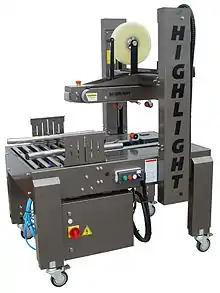

A case sealer or box sealer is a piece of equipment used for closing or sealing corrugated boxes. It is most commonly used for regular slotted containers (RSC) and can involve adhesive (cold water-borne or hot melt adhesive), box sealing tape, or Gummed (water activated) tape.
By contrast, a case erector is equipment for setting-up flat (knocked-down) corrugated boxes and applying a closure to the bottom flaps.
Semi-automated
With semi automatic equipment, the operator typically fills and loads a box at the entrance to the case sealer; the box may or may not have the bottom flaps previously closed. The operator closes the top flaps and feeds the box in or through a machine which automatically applies the closure. This helps save time and controls the application of the closure materials such as box sealing tape
Fully automated
Fully automatic equipment is available which does not require an operator. All functions, including closing the flaps, can be automated.
Other
Case sealers can also be categorized as either adjustable to fit production runs of a uniform box size or random, capable of handling a mixed variety of box sizes without machine adjustment.
Several machine design options have been developed.[1][2][3][4]
See also
Notes
- ↑ US 4044527, Ulrich, Lawrence Walter & Walker, Connie Wayne, "Apparatus for sealing containers", published 1977-08-30, assigned to Durable Packaging Corp.
- ↑ US 6067773, Le, Tuan Vinh, "Semi-automatic random box sealer", published 2000-05-30, assigned to 3M Innovative Properties Co.
- ↑ US 3775937, Devan, Frank & Devan, Fred, "Automatic random size box sealer", published 1973-12-04, assigned to Devon Tape Corp.
- ↑ US 5730831, Jensen, Jr., Van E.; Mitchell, Michael R. & Vasilakes, Lloyd S., "Adjustable tape width case sealer", published 1998-03-24, assigned to Minnesota Mining and Manufacturing Company
References
- Yam, K.L., "Encyclopedia of Packaging Technology", John Wiley & Sons, 2009, ISBN 978-0-470-08704-6
External links
 Media related to Case sealer at Wikimedia Commons
Media related to Case sealer at Wikimedia Commons